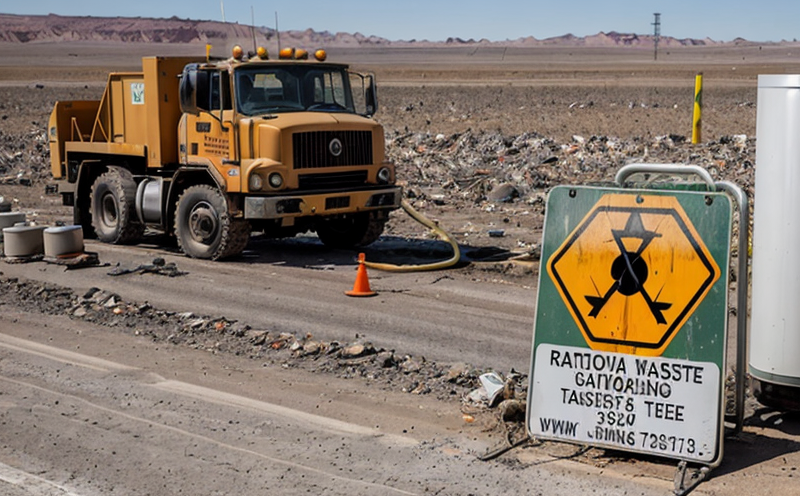ISO 18589-15 Measurement of Radionuclides in Wastewater Effluents
The measurement of radionuclides in wastewater effluents is a crucial process for regulatory compliance, environmental protection, and public health. ISO 18589-15 provides standardized methods to measure radionuclides in liquid samples, particularly focusing on the determination of radionuclides in nuclear fuel cycle facilities’ effluent streams. This service ensures accurate and reliable data that can be used for regulatory reporting.
This method is especially important as it helps in understanding the environmental impact of radioactive waste generated during various industrial processes. It allows organizations to monitor their compliance with national, regional, and international regulations concerning radioactive material discharge into water bodies.
The standard specifies procedures for sample preparation, pretreatment, and measurement techniques using gamma spectrometry or liquid scintillation counting (LSC). The protocol emphasizes the importance of minimizing contamination during sampling and analytical processes to ensure accurate results. This is critical because even trace amounts of radionuclides can pose significant risks if not properly managed.
One of the key aspects of this service involves thorough sample preparation, which includes filtering large volumes of water through appropriate filters, followed by dissolution in suitable solvents. The choice of solvent and filtration method greatly affects the accuracy of subsequent measurements; therefore, precise adherence to ISO 18589-15 guidelines is essential.
Once prepared, samples are analyzed using high-purity germanium detectors for gamma spectrometry or liquid scintillation counters for LSC. These instruments must be calibrated regularly according to the manufacturer's specifications to ensure consistent and accurate readings. The detection limits specified in ISO 18589-15 allow laboratories to quantify even minute quantities of radionuclides, making this a robust tool for environmental monitoring.
The process also involves quality assurance measures such as duplicate sample analysis, spike recovery tests, and reference material verification. These steps help ensure that the results obtained are both reproducible and reliable across different laboratories.
Understanding the complexities involved in measuring radionuclides requires a deep dive into the nuances of this ISO standard. For instance, the selection of appropriate analytical techniques depends heavily on the type and concentration levels of radionuclides present in the sample. Different isotopes may require different detection methods due to their varying properties like emission energies or half-lives.
Another critical factor is ensuring that all personnel handling radioactive materials follow stringent safety protocols outlined by organizations such as the International Atomic Energy Agency (IAEA) and Occupational Safety and Health Administration (OSHA). Proper training and adherence to these guidelines not only protect human health but also safeguard against accidental releases into the environment.
Furthermore, continuous improvement in laboratory practices through regular audits and performance evaluations helps maintain high standards of accuracy and reliability. By staying updated with advancements in technology and methodologies prescribed by ISO 18589-15, laboratories can provide clients with accurate data that contribute to informed decision-making regarding radioactive waste management.
- Accurate measurement of radionuclides helps prevent environmental contamination.
- Ensures compliance with international regulatory requirements for nuclear fuel cycle facilities.
Benefits
- Achieves compliance with stringent environmental regulations.
- Promotes sustainable industrial practices by minimizing radioactive waste discharge into water bodies.
- Provides reliable data for informed decision-making regarding nuclear fuel cycle processes.
- Ensures the safety of personnel involved in handling and analyzing radioactive materials.
International Acceptance and Recognition
The ISO 18589 series has gained widespread acceptance across numerous countries, including those adhering to European Union directives and United States Environmental Protection Agency guidelines. Compliance with these standards is mandatory for nuclear fuel cycle facilities operating within these jurisdictions.
ISO 18589-15 specifically addresses the measurement of radionuclides in wastewater effluents, which aligns closely with international efforts to reduce radioactive pollution. Its adoption reflects a commitment to global best practices aimed at protecting human health and preserving natural resources.
The standard is recognized by regulatory bodies worldwide because it provides consistent methods for quantifying radionuclides, thereby facilitating uniform reporting across different regions. This consistency enhances trust among stakeholders involved in nuclear fuel cycle activities globally.
Competitive Advantage and Market Impact
Adopting ISO 18589-15 measurement techniques offers significant competitive advantages for organizations engaged in nuclear fuel cycle processes. By ensuring precise measurements of radionuclides, companies can demonstrate their commitment to environmental stewardship and regulatory compliance.
This capability also enhances market reputation, as consumers and investors increasingly value responsible corporate practices. Demonstrating proficiency with this internationally recognized standard sets a benchmark for excellence in radioactive waste management.
Moreover, adherence to ISO 18589-15 helps minimize operational risks associated with accidental releases of radioactive materials into the environment. This proactive approach fosters stakeholder confidence and reduces potential liabilities.





